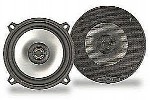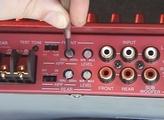Coaxial Speakers

The least expensive and most common type of car speaker is the coaxial. The coaxial consists of a midrange/woofer with a tweeter placed over the cone, either on a bridge or on a pole that extends from the middle of the cone. These speakers are made in sizes that will exactly fit most brands of vehicles. Advantages of this design include low cost, ease of installation, and a speaker that more closely approaches the one loudspeaker ideal, also called a point source. This is where all frequencies appear to originate from the same location. The disadvantage of this design is a generally lower sound quality for the majority of coaxials available versus the majority of matched component sets available.
Aspects and features that need to be considered when purchasing coaxials are:
Frequency Response: This is the how much of the audible spectrum a loudspeaker can reproduce. The value should be given with a rating of +/- some number of decibels, usually three. The greater the frequency range, the better up to 20kHz and down to 20Hz. Realistically a coaxial speaker will not play much below 80Hz. That's why we have subwoofers.
Mounting Depth: This is the distance that a speaker needs behind its mounting surface for its basket and magnet structure. This can be very important when speakers are being installed in the rear deck of automobile that has torsion bars in the trunk or door speakers with window clearance problems.
Power Handling: This is the amount of power a speaker can withstand before failing after a given amount of time. The most important number is the speakers continuous or RMS (root mean square) power handling. Peak power handling means virtually nothing.
Sensitivity: This is a reference measure of how loud a speaker will be with a certain amount of power at a certain distance. The standard is one watt at one meter. By halving the distance an increase of six decibels will be realized and doubling the power will increase the output by three decibels. This is a trick used by some companies to make their speakers appear more efficient than they are. Most loudspeakers will be in the ninety decibel range. Keep in mind that a difference of three decibels is equivalent to a doubling of the amplifier power.
Tweeter Protrusion: The height that a tweeter sticks above its mounting surface. This will need to be considered when coaxials are being mounted in factory locations under factory grills.
Component Speakers
A component loudspeaker is a single driver designed to reproduce frequencies in a given range. Component speakers are used in tandem with other component speakers to reproduce the entire audio spectrum. As few as two and as many as four or more different size drivers can be used to create a component set. The drivers are kept operating within their designed audio band (frequency range) by a series of frequency filters known as a crossover. By using a crossover to keep speakers operating within a certain range the speakers do not become distorted trying to reproduce frequencies that they are physically unable to reproduce. Check the chart to see the approximate frequency ranges of the various component drivers.
 In order to keep the point source attribute with a set of component speakers these speakers must be placed very near each other. However this is not always done in practice. Sometimes a midrange/woofer will be placed in a door while the tweeter may be placed in the front corner of the front window (sail panel) or on the pillar that separates the windshield from the door frame (A-pillar). This is done to raise the apparent position of the musicians on an imaginary stage in the front of the vehicle.
In order to keep the point source attribute with a set of component speakers these speakers must be placed very near each other. However this is not always done in practice. Sometimes a midrange/woofer will be placed in a door while the tweeter may be placed in the front corner of the front window (sail panel) or on the pillar that separates the windshield from the door frame (A-pillar). This is done to raise the apparent position of the musicians on an imaginary stage in the front of the vehicle.
It is generally considered desirable to have a sound system that gives the impression that the musicians exist on a stage across the top of the dash, extending beyond the edges of the dash. Raising the tweeter level can help in this goal but other problems can occur such as time alignment, the difference in time it takes the low and high frequencies to reach your ears. Ideally all frequencies should arrive at your ears at the same time.
Advantages of this design are generally better sound and more options for installation. Disadvantages are added cost, more complex installation, and possible problems with time alignment.
Aspects and features that need to be considered when purchasing components are:
Frequency Response: This is the how much of the audible spectrum a loudspeaker can reproduce. The value should be given with a rating of +/- some number of decibels, usually three. The greater the frequency range, the better up to 20kHz and down to 20Hz. Realistically a component speaker will not play much below 80Hz. That's why we have subwoofers.
Mounting Depth: This is the distance that a speaker needs behind its mounting surface for its basket and magnet structure. This can be very important when speakers are being installed in the rear deck of automobile that has torsion bars in the trunk or door speakers with window clearance problems.
Power Handling: This is the amount of power a speaker can withstand before failing after a given amount of time. The most important number is the speakers continuous or RMS power handling. Peak power handling means virtually nothing.
Sensitivity: This is a reference measure of how loud a speaker will be with a certain amount of power at a certain distance. The standard is one watt at one meter. By halving the distance an increase of six decibels will be realized and doubling the power will increase the output by three decibels. This is a trick used by some companies to make their speakers appear more efficient than they are. Most loudspeakers will be in the ninety decibel range. Keep in mind that a difference of three decibels is equivalent to a doubling of the amplifier power.

You may also be interested in How to Install Your Own Car Stereo System . It covers many topics including in depth car audio amplifier installation. Click here.
Next Page ---> Car Speaker Placement